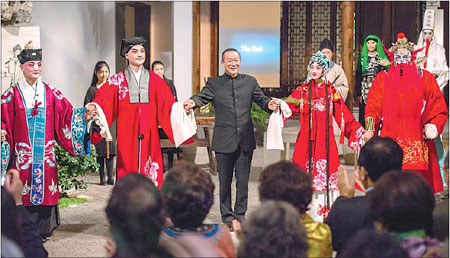
 'Taken 2' grabs movie box office crown
'Taken 2' grabs movie box office crown
 Rihanna's 'Diamonds' tops UK pop chart
Rihanna's 'Diamonds' tops UK pop chart
 Fans get look at vintage Rolling Stones
Fans get look at vintage Rolling Stones
 Celebrities attend Power of Women event
Celebrities attend Power of Women event
 Ang Lee breaks 'every rule' to make unlikely new Life of Pi film
Ang Lee breaks 'every rule' to make unlikely new Life of Pi film
 Rihanna almost thrown out of nightclub
Rihanna almost thrown out of nightclub
 'Dark Knight' wins weekend box office
'Dark Knight' wins weekend box office
 'Total Recall' stars gather in Beverly Hills
'Total Recall' stars gather in Beverly Hills
Classic Chinese opera captivates New York
Updated: 2012-12-04 09:48
By Liu Yuhan (China Daily)
|
||||||||
 |
|
Academy Award winner and director of The Peony Pavilion Tan Dun greets the audience with cast members at the Astor Court in New York's Metropolitan Museum of Art. Stephanie Berger / for China Daily |
Met stages The Peony Pavilion in Ming Dynasty-style garden court
Related video: Classical opera comes to Met's Chinese garden
The Peony Pavilion, a masterpiece of Chinese Kunqu opera from the 16th century, proved its durability by thrilling New Yorkers in a fresh production directed by Academy Award-winning composer Tan Dun.
Co-produced by the Metropolitan Museum of Art and the US-China Cultural Institute, Tan's version blends opera with lush backdrops from the eight-gallery exhibition Chinese Gardens: Pavilions, Studios, Retreats in the museum's Astor Court.
The Met opened the Astor Court in 1981, in an early example of a China-US cultural exchange. It's modeled on a courtyard in the Master of the Fishing Nets garden in Suzhou, Jiangsu province, in East China.
The original, built in the 12th century and restored in 1785, is recognized as a World Heritage Site by the United Nations Educational, Scientific and Cultural Organization.
Shirley Young, chairwoman of the US-China Cultural Institute, said the collaboration is meant to integrate visual arts with traditional Chinese performing arts in order to enhance the audience's experience.
"This is the first time that an operatic performance has taken place in the Astor Court, the first authentic Ming Dynasty-style garden court constructed outside China," she said.
Much as the Suzhou gardens took designers and craftsmen years to complete, Tan's 70-minute version of The Peony Pavilion was a long-term labor of love.
"I started to have a dream five years ago," said Tan, who won the Academy Award for Best Original Score in 2000 for Crouching Tiger, Hidden Dragon.
"A couple of years later, during the (2010) Shanghai Expo, I was having tea one day in garden surroundings," he recalled.
"All of a sudden I was inspired by the beauty of flowers, singing birds, fish, the flowing water. Then I asked myself, 'Why not stage a show that can blend the beauty of traditional Chinese gardens?'"
The opera, whose four-day run ended on Sunday, attracted prominent guests, including many involved in international cultural exchanges such as UNESCO's assistant director-general for strategic planning Hans d'Orville, China's permanent representative to the UN Ambassador Li Baodong and head of the Met's Asian art department Maxwell Hearn.
"There is a mood established by the haunting sound of the guqin, the bamboo flute - all the traditional Chinese instruments. They were extremely evocative and brought a new kind of life to our garden," Hearn said. "The opera has accomplished so many things, the way it's brought together with the works of art and the surrounding galleries."
D'Orville said: "You can see the tangible culture and intangible culture get together beautifully. You are not only coming for the beautiful Kunqu opera, but also the link to the music, the link to the real environment."
Written by Tang Xianzu during the Ming Dynasty (1368-1644), The Peony Pavilion is a story of lovers united in dreams. Since its presentation in 1598, it has come to be regarded as the most important work of Kunqu opera. Performances are often in gardens, another integral part of Chinese culture.
In 2001, UNESCO designated Kunqu opera "a masterpiece of the oral and intangible heritage of humanity".
Contact the writer at liuyuhan11@chinadailyusa.com
Most Viewed
Editor's Picks

|

|

|

|

|

|
Today's Top News
Health new priority for quake zone
Xi meets US top military officer
Japan's boats driven out of Diaoyu
China mulls online shopping legislation
Bird flu death toll rises to 22
Putin appoints new ambassador to China
Japanese ships blocked from Diaoyu Islands
Inspired by Guan, more Chinese pick up golf
US Weekly

|

|






